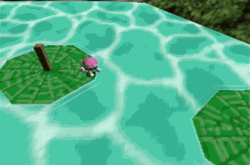 The Nintendo NX is on the horizon, and it seems like every gamer in existence is scrambling to explain exactly why the WiiU failed. First of all, the WiiU did not fail, because it can play both Super Metroid and Super Smash Bros 4 WiiU, and that’s just super. But if you want to subscribe to the “WiiU failed” philosophy, a popular theory states that the WiiU never went anywhere because third parties refused to support the WiiU gamepad with any sort of consistency. Or, if there was support, it was half assed and did not enhance the play experience at all. The WiiU is a failure because no one ever figured out how to use its central gimmick, and, naturally, the public followed suit and didn’t buy the device, metaphorically and literally.
The Nintendo NX is on the horizon, and it seems like every gamer in existence is scrambling to explain exactly why the WiiU failed. First of all, the WiiU did not fail, because it can play both Super Metroid and Super Smash Bros 4 WiiU, and that’s just super. But if you want to subscribe to the “WiiU failed” philosophy, a popular theory states that the WiiU never went anywhere because third parties refused to support the WiiU gamepad with any sort of consistency. Or, if there was support, it was half assed and did not enhance the play experience at all. The WiiU is a failure because no one ever figured out how to use its central gimmick, and, naturally, the public followed suit and didn’t buy the device, metaphorically and literally.
First of all, bull$!&#, because a good game no more needs a system’s gimmick than Super Mario Galaxy needed Fluzzard. If the games are good and plentiful, people buy the system, same as it’s ever been.
But more importantly, here’s a fun fact, no game developer has ever understood Nintendo innovations.
Look at the Wii. How many third party games effectively used the WiiMote? And how many third party games just implemented some useless “waggle” function? Do you think Castlevania Judgment was released on the Wii because that was the only system that could support the raw masculinity of Grant Danasty? Or was it because the Wii was the bestselling system of the generation, so, ya know, install base? I’ve said it before, but even Nintendo was incapable of surpassing the promise of its flagship system’s launch game, so what hope did everyone else have? You can only masturbate Travis Touchdown so many times before you realize that something has gone terribly wrong.
But the Wii still sold like solid gold cocaine at a Billionaires Anonymous meeting, so nobody had to sit in their thinking chair and figure out how to make this gimmick “work”.
Similarly, there’s the N64. I can hear some of you young’uns now, throwing up your newfangled cellular telephones in anguish and asking, “What gimmick? The N64 had no gimmick!” And to that I 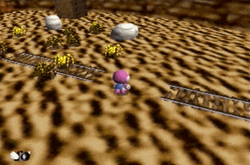 answer with the age old adage, “Yesterday’s innovation is today’s standard, and get off my lawn.” The analog stick was once all new and all different. The N64’s analog stick was an invention that had previously only been seen in novelties that were as limited as light guns and dance pads. Yes, the Atari had its big ol’ control stick, but it had been a decade since anyone saw that as standard. The Sega Saturn would try its hand at the analog game shortly after the N64, but even there, it was only intended for one (albeit very good) game. The analog stick would eventually become as standard for every system as the cross pad before it, but, when it was released, the N64’s controller was a new paradigm.
answer with the age old adage, “Yesterday’s innovation is today’s standard, and get off my lawn.” The analog stick was once all new and all different. The N64’s analog stick was an invention that had previously only been seen in novelties that were as limited as light guns and dance pads. Yes, the Atari had its big ol’ control stick, but it had been a decade since anyone saw that as standard. The Sega Saturn would try its hand at the analog game shortly after the N64, but even there, it was only intended for one (albeit very good) game. The analog stick would eventually become as standard for every system as the cross pad before it, but, when it was released, the N64’s controller was a new paradigm.
And developers… don’t tend to deal well with “different”. A number of N64 games ignored the control stick’s advantages (Mortal Kombat Mythologies: Sub-Zero and Mischief Makers spring immediately to mind), or simply used it as if it were last generation’s crosspad. Yes, games that were biting on Mario 64 or Ocarina of Time used the analog stick to the fullest… but is it that hard to figure out how to use a “gimmick” when you’re stealing from the best?
One could probably claim that Chameleon Twist is yet another third party N64 game aping Mario 64. You’ve got your choice of four differently colored (but exactly the same) cartoon mascot creatures (Davy, Jack, Fred, and Linda… Linda is the girl!) exploring a fantastical polygonal 3-D world that also seems to be home to a number of deadly whatsits, like porcupines, spiders, and man eating chipwiches. Run, jump, and use your chameleon’s natural acrobatic prowess to conquer the worlds and escape this fairytale universe.
But Chameleon Twist has one gimmick all its own, and it’s right there in the title. Your chameleon of choice has a long, sticky tongue that has completely absurd reach and strength. Open that lizard maw, and out extends an organ that, depending on the size of the level, can reach from one end of the screen to the other. But this tongue isn’t just there to depress the KISS Army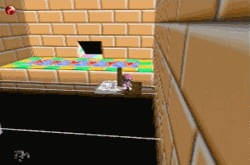 , no, your chameleon can use that tongue for the most obvious reason (in a video game, anyway): to gobble up items and enemies. Or use it for more amazing feats, like dragging Davy and his friends across wide gaps and into conveniently placed wooden stakes. But wait, there’s more! You can even swing around these poles by your tongue, like some kind of licking-based Matterhorn. And, if all else fails, there’s always the option to shoot that tongue straight down, and taste the ground as a pole-vaulter. Who knew so much was possible when you have a tongue that’s ten times the length of your body?
, no, your chameleon can use that tongue for the most obvious reason (in a video game, anyway): to gobble up items and enemies. Or use it for more amazing feats, like dragging Davy and his friends across wide gaps and into conveniently placed wooden stakes. But wait, there’s more! You can even swing around these poles by your tongue, like some kind of licking-based Matterhorn. And, if all else fails, there’s always the option to shoot that tongue straight down, and taste the ground as a pole-vaulter. Who knew so much was possible when you have a tongue that’s ten times the length of your body?
Of course, all of these moves are nowhere near unique. Yoshi, for instance, has been licking up enemies since the 16-bit days, and, while the use of a tongue might be a little distinctive, all the lassoing style abilities have been performed with a length of rope by other video game protagonists, generally stiff Belmonts included. But what’s different here is how the tongue “controls”. From the moment you hit the… tongue button, you have 100% control over the direction and extension of that chameleon tongue. What’s more, thanks to the N64 analog stick, that tongue controls smooth as silk, so, if you can master walking, you can perform complicated tongue maneuvers (lickneuvers?). Sure, you could probably try to make a similar game on a system with a crosspad, but it just wouldn’t feel right. Tongues aren’t meant for sharp angles; they are meant to twist.
So what can we learn from Chameleon Twist? Well, I suppose the most obvious answer is that it doesn’t take Nintendo or an AAA studio to produce a game that 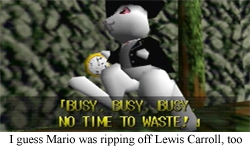 can properly utilize Nintendo’s latest gimmick hardware. Chameleon Twist isn’t an amazing game by any means, but it feels right, and I can’t imagine it on any other system from its parent era. In time, the analog stick would become standard across all systems, but Chameleon Twist was bold enough to find a use for it well before it was a part of every wireless controller. In its epoch, CT was a rare spin on a gimmick, and it licked the competition.
can properly utilize Nintendo’s latest gimmick hardware. Chameleon Twist isn’t an amazing game by any means, but it feels right, and I can’t imagine it on any other system from its parent era. In time, the analog stick would become standard across all systems, but Chameleon Twist was bold enough to find a use for it well before it was a part of every wireless controller. In its epoch, CT was a rare spin on a gimmick, and it licked the competition.
So when the Nintendo NX hits, I guess we should call Sunsoft. Maybe they’ll come up with a game that will give the new hardware an interesting… twist.
FGC #121 Chameleon Twist
- System: N64. It seems like every time I type that, it’s after an article that mostly talks about the N64 hardware. I guess it was a pretty distinctive system.
- Number of players: Four, actually, because there’s a Versus Mode that allows everyone to play, basically, king of the hill. It’s… weird, but not completely unwelcome. Between the multiplayer mode, polygonal graphics, and analog control, Sunsoft was really playing to the N64’s strengths.
- Liking Sunsoft now? Well, they were responsible for Blaster Master and Waku Waku 7, two of my favorite games at random points in my existence. They were also responsible for Fester’s Quest and Aero the Acro-Bat, though. At least their games were generally… eclectic.
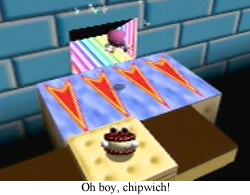 For the sequel: Chameleon Twist was continued in Chameleon Twist 2, which featured practically the same plot, but slightly modified chameleons. I find it odd that this game was enough of a hit to warrant a sequel, but it’s not like the N64 had a wealth of options…
For the sequel: Chameleon Twist was continued in Chameleon Twist 2, which featured practically the same plot, but slightly modified chameleons. I find it odd that this game was enough of a hit to warrant a sequel, but it’s not like the N64 had a wealth of options…- An End: The Western release of Chameleon Twist doesn’t really have an ending, aside from the fact that your chameleon is just trying to get home, and I guess the credits are supposed to imply that happened. The Japanese release, though, involves an “epic” exploding final boss, and a triumphant escape sequence. Good thing Youtube came along a decade later to fill us in on that amazing revelation.
- Did you know? It sounds like some playground rumor, but if you beat the game once, there will be a star on your title screen. That star goes away if you play the game again and get hit by anything. However, if you beat the game again without ever taking damage, a secret code will be displayed on the title screen. This code… does nothing. Seriously. People are still trying to figure it out.
- Would I play again: It’s a neat N64 game… but it’s still an N64 game. Man, that system has some ugly graphics. Pass.
What’s next? Random ROB has chosen… Bravely Default for the 3DS! It might have a stupid name, but it’s not a stupid game. Please look forward to it!
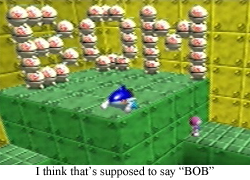

Chameleon Twist is a series I’d really like to see rebooted with modern game design sensibilities* and good level design, and it’s not only ‘cuz I like the concept of a game where you can have a cute lizard girl** (or one of those other three I guess) do all kinds of crazy acrobatics using her tongue.
…Okay, okay, it’s MAINLY because I like a cute lizard girl doing all kinds of crazy acrobatics with her tongue. ^^;
Still, wouldn’t be too far a stretch to make the chameleons from 1 and the Japanese 2 look like they came right out of Sgt. Frog with a few minor design changes, and it shouldn’t be hard to make better levels than a 1997 third party platformer had.
* Infinite continues and starting you off at the start of the last room where you died was pretty forward-thinking for a 3D platformer, though.
** Going by the GIFs I can see I’m not the only one who prefers Linda to the other three, even though she’s just an alt skin. =3
I just thought Linda looked like she was the chameleon most on the ball…
[…] given video game. Teenagers are easy marks, but what about the myriad of “others” out there? Chameleon Twist is by no means a pornographic game, but that doesn’t mean a lick to tongue fetishists. Have a […]
[…] yes, having a tongue whip is pretty cool, but there are other lizards out there. Are there any alligators in the cast? […]
[…] He’s weak to ice, but there’s always a twist with chameleons. […]